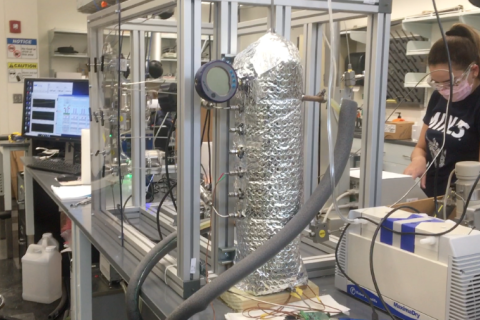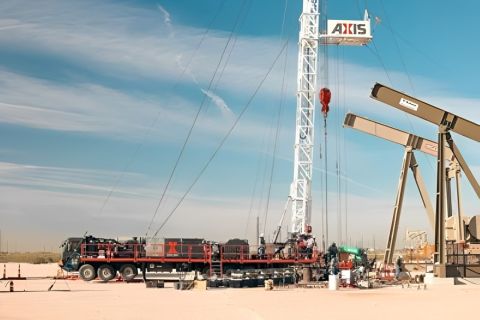In today’s environmentally conscious energy industry, the push for the use of natural gas is at an all-time high, and energy forecasts show that this effort will continue to grow. Additionally, the need for fracturing equipment to meet rigorous new US Environmental Protection Agency (EPA) Tier IV standards for emissions by 2015 has strained the resources of manufacturers and service companies.
Green Field Energy Services (GFES) already meets these strict emissions limits and can use 100% natural gas by providing solutions that center around turbine fracturing pump (TFP) technology. GFES uses military-grade turbine engines to power the TFPs, which provide four major improvements vs. conventional fracturing equipment in the areas of emissions, reduced footprint, fuel source flexibility, and significant cost consideration.
Turbine pumping technology
The turbines that GFES uses have many benefits. Not only do they make tremendous power even at low output speeds, but they also can run multiple fuels and have a longer service life than reciprocating engines. The key to unlocking the potential of the turbines is a split shaft design that allows the output speed to be finely controlled. Through a proprietary reduction gear box, power is efficiently transferred to a conventional positive displacement plunger pump. Older turbine-powered fracturing equipment was of a completely different design and had several limitations that increased HSE risks. These risks have been eliminated with the advent of the reduction gear box, advanced control software, and failsafe engineering.
Emissions
When compared to conventional fracturing equipment, the TFPs emit 87% less nitrogen oxide and carbon monoxide, which passes the EPA Tier IV standard when powered by diesel. When using fuel sources such as 100% LNG, 100% compressed natural gas (CNG), or 100% field gas, these emissions are reduced further and are found in trace amounts. These lower pollutant emissions, combined with the overall reduction in carbon emissions from using natural gas, mean that one turbine-powered fracturing spread running on natural gas has the equivalent emissions reduction of a fleet of more than 250 city buses running on natural gas.
Reduced footprint
A standard multiwell fracturing pad generally will have dimensions of approximately 137 m by 85 m (450 ft by 280 ft). With the ability to stack the turbines above the fluid ends, each trailer can accommodate two fracturing pumps, thereby increasing the hydraulic horsepower (hhp) capacity of each trailer from 2,250 hhp to 4,500 hhp. This translates to a reduction in pad size and construction cost by being able to feature the same amount of hhp and auxiliary equipment in a space that is only 99 m by 85 m (325 ft by 280 ft). Pad size construction costs have thus been reduced by approximately one-third.
Fuel source flexibility
For more than 60 years diesel fuel has been the primary fuel source of oil and gas well stimulation equipment. The industry, in all segments, is transitioning into using alternative fuel sources. TFPs with GFES’ Multi+Fuel capability are the only turbines in the industry that can
use 100% field gas (delivered directly from an offset wellhead or sales line), 100% LNG or CNG, or No. 2 diesel. Other technologies on the market are limited to using a combination of alternative fuels and diesel, with, at most, a 50% substitution of alternative fuel for diesel.
This advanced fuel control system, designed by Tucson Embedded Systems, allows for immediate and automatic adjustments for changes in fuel quality or composition so that the maximum efficiency of the turbine is obtained, regardless of the fuel source. The flexibility of the system allows a single spread of equipment to operate on field gas one day, LNG the next day, and diesel fuel the following day – all without a single adjustment or calibration from a technician. Because the fuel source decision only depends on availability and economics, operators are not required to make compromises in their fueling because of equipment limitations.
Cost savings
Typically, fracturing invoice fuel costs comprise approximately 12% to 15% of the total invoice amount. When using field gas these costs are reduced by 78%. Therefore, the total fracturing cost is reduced by more than 10% simply by changing to a cleaner burning fuel. Using natural gas adds value to the operator by reducing overall drilling and completion costs, which can maximize profitability. Because less capital is being spent on fuel for fracturing jobs, the operator is able to invest in new techniques, infrastructure, and the communities in which operations are occurring.
Field gas, where practical for fracturing use, is an extremely economic fuel source. The price differential to diesel can be fully realized through the use of 100% field gas, and Multi+Fuel can allow for 100% field gas use. GFES is currently working with an operator in the Marcellus shale that is delivering field gas directly to the fracturing spread. Because delivery of field gas is a new technique, the operator chose to ramp up the number of pumps using the fuel instead of diesel. Ramping in this way allowed the operator to know for certain that gas can be delivered at the rates and pressures required for powering the fracturing equipment. It did not take long to realize that the gas was available, and the operator has realized significant savings in fuel cost and reduction of harmful emissions by using its own field gas.
Actual fuel consumption data during a multistage fracturing job demonstrated an average of 19.8 Mcf/hr of pumping time, with each pump averaging 7.5 bbl/min and 8,100 psi. When 100% of diesel fuel is replaced by natural gas, fuel costs are reduced to less than 25% of the diesel cost for a fracturing spread. Using unit costs for fuels of US $4/gal for diesel and $3.75/Mcf for natural gas, the chart below shows the savings realized by the operator vs. a conventional fracturing spread.
Natural gas delivery
Natural gas is delivered from whatever source is chosen by the operator to a conditioning skid to remove water from the gas supply. Any additional gas processing that is needed can occur at this point as well. From there, the gas is delivered to the pumps via the GFES Mantis gas delivery system that connects each fracturing pump together in a daisy chain. This system uses specially engineered connections with a proprietary swing arm to allow for easy rigup, minimal pressure loss, and effective mitigation of HSE risks. All sides of the pump are easy to access since piping is overhead and out of the walkway between pumps.
In the Marcellus shale the system minimized natural gas connections on location by connecting each pump together. Only two supply hoses were required – one to either bank of pumps on the fracturing manifold.
Should a pump need to be removed from its spot in line for any reason, the system allows for quick disconnection and quick reconnection to the replacement pump. Minimal pressure loss is observed along the line of the pumps, and all pumps have more than adequate natural gas available for smooth operation.
Recommended Reading
Defeating the ‘Four Horsemen’ of Flow Assurance
2024-04-18 - Service companies combine processes and techniques to mitigate the impact of paraffin, asphaltenes, hydrates and scale on production—and keep the cash flowing.
Going with the Flow: Universities, Operators Team on Flow Assurance Research
2024-03-05 - From Icy Waterfloods to Gas Lift Slugs, operators and researchers at Texas Tech University and the Colorado School of Mines are finding ways to optimize flow assurance, reduce costs and improve wells.
AI Poised to Break Out of its Oilfield Niche
2024-04-11 - At the AI in Oil & Gas Conference in Houston, experts talked up the benefits artificial intelligence can provide to the downstream, midstream and upstream sectors, while assuring the audience humans will still run the show.
Axis Energy Deploys Fully Electric Well Service Rig
2024-03-13 - Axis Energy Services’ EPIC RIG has the ability to run on grid power for reduced emissions and increased fuel flexibility.
Curtiss-Wright to Deploy Subsea System at Petrobras' Campos Field
2024-02-12 - Curtiss-Wright and Petrobras will combine capabilities to deploy a subsea canned motor boosting system at a Petrobras production field in the Campos Basin.





